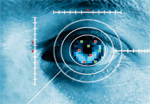
Seeing Through the Lies
Hard as one may try, our bodies do not lie. In
addition to the polygraph and fMRI brain
scans that measure physiological responses
when someone is lying, researchers at the University
of Utah have created ocular motor deception detection
technology, which employs eye-tracking technology
to measure cognitive responses, specifically pupil
dilation, to determine when someone is lying.
The University of Utah researchers -- educational
psychologists John Kircher, Doug Hacker, Anne
Cook, Dan Woltz and David Raskin -- say they are
the first to develop and assess the software and methods
for applying these tests effectively.
Promising Results
In a mock crime lab scenario, the researchers designed
an experiment using an office setting with a secretary,
who has money in her purse, and another employee.
The employee is instructed to steal $20 from the
purse, and then he or she takes the test. The subject
sits at computer screen with an eye-tracking device to
answer true or false questions.
The test takes approximately 25 minutes, and the
software measures and analyzes pupil dilation and
eye movements to determine truthfulness. The software
also records and measures answer response time,
reading and rereading time and errors. The researchers
determined that lying requires more work than telling
the truth, so they look for indications that the subject
is working hard. For example, a person who is being
dishonest may have dilated pupils and take longer to
read and answer the questions. The software accounts
for these minute reactions by employing sophisticated
measurement and statistical modeling.
The end result yields either a green, red or yellow
indicator. Green means the subject is being truthful,
red means deceptive and yellow means the results are
questionable.
New Technology Offers More Benefits
Ocular motor deception detection technology is not
intended to replace the polygraph; the intent is to offer
an alternate method. At this stage, researchers need
to find a field-test venue. The Employee Polygraph
Protection Act prohibits the private sector from using
lie-detection tests for pre-employment testing, but the
researchers are hopeful the technology will prove effective
for pre-employment screening of government
employees and for screening visa applicants.
Numerous government agencies, such as the U.S.
Department of Defense, Department of Homeland
Security, Customs and Border Protection, Department
of Energy, FBI and CIA, as well as European
banks, use polygraphs to screen employees and job
applicants. The researchers recommend administering
their test prior to a polygraph. If a subject fails
the test, then they would move on to the polygraph for
a secondary testing.
Ocular motor deception detection technology offers
the same accuracy as a polygraph, but at a fraction
of the cost because the test does not require a
skilled examiner. Instead, the test is administered by
a technician who manages a computer preloaded with
the researchers’ software.
“The accuracies in our three experiments have
ranged from 82 to 91 percent,” Kircher said. “Under
ideal conditions, polygraph accuracy in specificincident
criminal cases is 90 percent. In screening
situations, which is where we think our eye tracking
technology will be most useful, polygraph accuracy
probably is closer to 80 percent.”
Also the eye-tracking method requires one-fifth of
the time currently needed for polygraph tests, requires
no attachments to the subject and is available in any
language.
One Step Closer
Recently, the University of Utah licensed the technology
to Credibility Assessment Technologies,
based in Park City, Utah, and managed by venture
capitalists Donald Sanborn and Gerald Sanders,
who are the president and chairman, respectively.
This milestone brings the technology one step closer
to market.
“The eye-tracking method for detecting lies has
great potential,” Sanders said. “It’s a matter of national
security that our government agencies have the
best and most advanced methods for detecting truth
from fiction, and we believe we are addressing that
need by licensing the extraordinary research done at
the University of Utah.”
“We have gotten great results from our experiments,”
Kircher said. “They are as good as -- or better --
than the polygraph, and we are still in the early
stages of this innovative new method to determine if
someone is trying to deceive you.”
“I came to the University of Utah to do work in
reading comprehension, but I jumped at the chance
to get involved with this research,” Cook said. “That’s
the fun of this kind of job. You get the opportunity to
collaborate with your colleagues to achieve more than
any of you could individually.”
The researchers still have more work to do, but
they hope the licensing will help them attract additional
funding and interest from potential customers.
“It’s exciting that our testing method is going to be
taken from a basic research program to commercial
use,” Cook said.
This article originally appeared in the issue of .
About the Author
Sherleen Mahoney is a Web managing editor at 1105 Media.